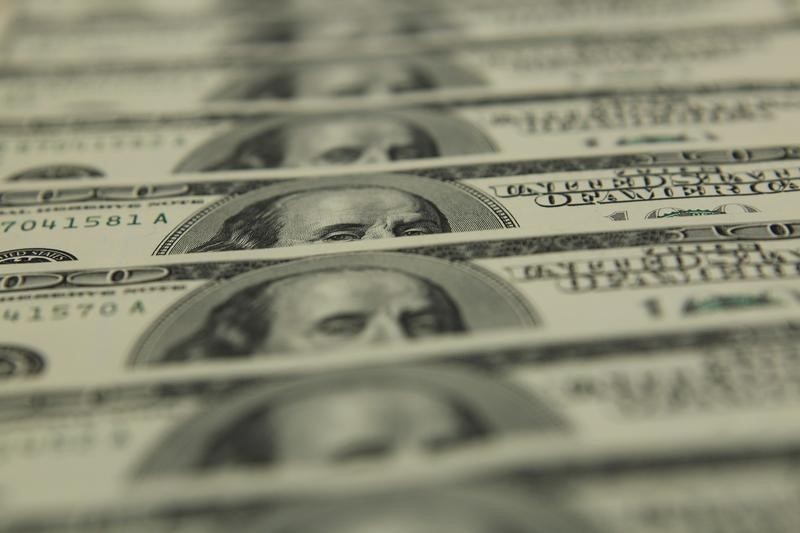(Corrects second bullet point to show euro makes biggest daily fall in 2 years, not hitting lowest level in 2 years)
* ECB vows to keep subzero rates until next year
* Euro makes biggest fall in 2 yrs; dollar index up sharply
* Wall Street creeps positive while Euro equities jump 1.25 pct
By Nick Brown
NEW YORK, June 14 (Reuters) - The U.S. dollar rose more than a penny against a basket of major currencies as the euro cratered, and U.S. stocks closed higher on Thursday, as the European Central Bank signaled interest rate hikes were a long way off.
The bank's unexpectedly dovish decision overshadowed its statement that it aimed to wrap up its crisis-era stimulus program at the end of this year. ECB now plans to reduce monthly asset purchases between October and December to 15 billion euros until the end of 2018 and then conclude the program.
Investors, though, seized on comments indicating that interest rates would stay at record lows at least through the summer of 2019, and some analysts believed it may be longer, with ECB President Mario Draghi's term due to expire at the end of October 2019.
The U.S. Federal Reserve on Wednesday decided to raise rates by a quarter of a percentage point, creating "a widening rate differential between the U.S. and Europe, and the dollar is the beneficiary," said Ed Egilinsky, head of alternative investments at Direxion in New York.
The euro EUR= marked its steepest one-day drop against the U.S. dollar since June 2016, and was down 1.75 percent at $1.1583.
The dollar index .DXY , which measures the greenback against six other top currencies, rose 1.17 percent. government bond yields in Germany, the euro zone benchmark, fell around 6 basis points to 0.422 percent compared with Wednesday's close DE10YT=RR . markets, pressured by the strengthening dollar and fears that OPEC countries could decide to increase output at a meeting next week, ended mixed.
West Texas Intermediate (WTI) crude oil futures CLc1 settled at $66.89 per barrel, up 0.38 percent, while Brent LCOc1 went the other way, settling down more than 1 percent at $75.94.
"The independent show of WTI strength is merely a catchup process to the higher priced products and Brent values," Jim Ritterbusch, president of Ritterbusch and Associates, said in a note.
EQUITIES STRONG
Benefiting from the euro zone dovishness: stock markets on both sides of the Atlantic.
Two of Wall Street's three main indexes closed in the black, with technology stocks leading the charge on the benchmark S&P 500. Helping boost stateside equities was a Commerce Department report showing retail sales rose 0.8 percent last month, the biggest advance since November 2017. Dow Jones Industrial Average .DJI fell 25.89 points, or 0.1 percent, to 25,175.31, but the S&P .SPX gained 6.86 points, or 0.25 percent, to 2,782.49 and the Nasdaq Composite .IXIC added 65.34 points, or 0.85 percent, to 7,761.04.
The ECB decision sent the pan-European FTSEurofirst 300 index .FTEU3 up 1.25 percent, buoyed by big gains in interest rate-sensitive sectors like autos and utilities. U.S. Treasuries, benchmark 10-year notes US10YT=RR last rose 12/32 in price to yield 2.9351 percent, from 2.979 percent late on Wednesday.
The 30-year bond US30YT=RR last rose 30/32 in price to yield 3.0545 percent, from 3.102 percent on Wednesday.
LOOKING AHEAD
As the Fed and the ECB provided much of the week's central bank fireworks, the Bank of Japan began a two-day policy meeting, though virtually no one was forecasting changes to its stimulative policy given recent signs of slowing growth.
Another issue that will keep investors in check is concern about U.S. threats to impose tariffs on $50 billion of Chinese goods. U.S. President Donald Trump was planning to meet with trade advisers to decide whether to activate the tariffs. corn and soybean futures tumbled as uncertainty about tariffs and favorable crop weather in the U.S. Midwest prompted funds to liquidate big long positions. CBOT July corn 1CN8 fell to its lowest since mid-January, and front-month soybeans Sc1 dipped to a 9-1/2-month low. a rare merging of the sports and trading worlds, markets are gearing up for soccer's World Cup in Russia, where time zone differences mean more matches during European, U.S. and Latin American trading hours than any previous tournament.
A study done during the last World Cup with similarly timed games, the 2010 finals in South Africa, showed trading volumes on share markets dropped by a third on average when matches were on and 55 percent when a market's own team played. Changes in stock market trading volumes during 2010 World Cup
https://reut.rs/2JGea55 Global asset performance since ECB signalled QE
https://reut.rs/2MrnMm0 GRAPHIC-Global assets in 2018
http://tmsnrt.rs/2jvdmXl GRAPHIC-Emerging markets in 2018
http://tmsnrt.rs/2ihRugV GRAPHIC-World FX rates in 2018
http://tmsnrt.rs/2egbfVh GRAPHIC-MSCI All Country World Index Market Cap
http://tmsnrt.rs/2EmTD6j
^^^^^^^^^^^^^^^^^^^^^^^^^^^^^^^^^^^^^^^^^^^^^^^^^^^^^^^^^^^>
